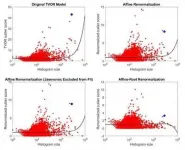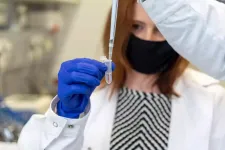Strategies to speed global vaccine availability
2021-06-29
(Press-News.org) NEW YORK (June 29, 2021)--In a new paper published in the journal Vaccine: X, public health experts from Columbia University Mailman School of Public Health, the University of Oslo, and Spark Street Advisors highlight actions to accelerate access to vaccines globally. The paper reviews the vaccine research and development process and proposes areas where reforms could increase access, speed time to market and decrease costs--from R&D to manufacturing and regulation to the management of incentives like patents and public funding.
The COVID-19 pandemic has highlighted the importance of vaccines as public health and pandemic preparedness tools and amplified the importance of issues ranging from equitable distribution to reliable supply of quality, affordable vaccines. Delays in time from the first dose in a high-income country to introduction at scale in a low-income country can take years. These delays are driven by several challenges, some of which are unique to the vaccine development ecosystem. The authors write that the patenting and overall intellectual property (IP) protection are complex, regulatory oversight is rigorous, manufacturing processes require technical support or know-how transfer from the innovator, and market dynamics create obstacles to delivering at scale. To address these challenges, the authors propose several opportunities to accelerate the availability of vaccines in low and middle-income countries:
Regulatory harmonization. Regulatory agencies around the world are increasingly recognizing the need to harmonize their approval process to enable efficiencies to save both time and money--something particularly important with regard to new technologies. For example, mRNA and DNA vaccines have the greatest potential of speeding the development processes and the recent approval of mRNA vaccine against COVID-19, brings promise for fully establishing regulatory pathways for these innovations. While mRNA vaccines do pose some challenges for low-income settings, in particular their requirement for ultra-cold storages, there are ongoing efforts to try to address this issue, including the establishment of a COVID-19 mRNA vaccine technology transfer hub.
Manufacturing capacity building. In order for vaccines to be deployed quickly and at scale, manufacturing capacity must be in place to allow for sufficient scale up when demand is high. Given the substantial know-how required, access to facilities is not enough; low-income countries and regions must also have sufficient know-how about manufacturing processes. This will require freedom to operate around patents and investment in technology transfer. To face the unprecedented need and opportunity for rapid and massive worldwide availability of COVID-19 vaccines, new business models have emerged with agreements between originator companies and manufacturing companies operating in different geographical and market environments.
Streamlined IP arrangements. With regard to IP arrangements, biopharmaceutical manufacturers and governments have made use of governmental compulsory licensing, patent oppositions, IP pools and voluntary IP licenses and technology transfer to advance access to new technologies. Although this has been limited in the field of vaccines, improving transparency and creating more streamlined IP arrangements, could contribute to increased diversity of supplier which will also help alleviate supply constraints.
"The COVID-19 outbreak and steps that have been taken to speed time to market could act as a catalyst for other vaccines," says senior author Nina Schwalbe, MPH, adjunct assistant professor of Population and Family Health. "While still very much a work in progress, the advancements demonstrated through the R&D of COVID-19 vaccines, give promise that many of the challenges to efficient and equitable vaccine development can be successfully addressed with adequate financing and political will."
INFORMATION:
Co-authors include Ole Kristian Aars, Spark Street Advisors and University of Oslo; and Michael Clar, Spark Street Advisors. The research was supported in part with funding from the Medicines Patent Pool.
Columbia University Mailman School of Public Health
Founded in 1922, the Columbia University Mailman School of Public Health pursues an agenda of research, education, and service to address the critical and complex public health issues affecting New Yorkers, the nation and the world. The Columbia Mailman School is the seventh largest recipient of NIH grants among schools of public health. Its nearly 300 multi-disciplinary faculty members work in more than 100 countries around the world, addressing such issues as preventing infectious and chronic diseases, environmental health, maternal and child health, health policy, climate change and health, and public health preparedness. It is a leader in public health education with more than 1,300 graduate students from 55 nations pursuing a variety of master's and doctoral degree programs. The Columbia Mailman School is also home to numerous world-renowned research centers, including ICAP and the Center for Infection and Immunity. For more information, please visit http://www.mailman.columbia.edu.
ELSE PRESS RELEASES FROM THIS DATE:
2021-06-29
A process that uses heat to change the arrangement of molecular rings on a chemical chain creates 3D-printable gels with a variety of functional properties, according to a Dartmouth study.
The researchers describe the new process as "kinetic trapping." Molecular stoppers--or speed bumps--regulate the number of rings going onto a polymer chain and also control ring distributions. When the rings are bunched up, they store kinetic energy that can be released, much like when a compressed spring is released.
Researchers in the Ke Functional Materials Group use heat to change the distribution of rings and then use moisture ...
2021-06-29
DURHAM, N.C. - Combining structural biology and computation, a Duke-led team of researchers has identified how multiple mutations on the SARS-CoV-2 spike protein independently create variants that are more transmissible and potentially resistant to antibodies.
By acquiring mutations on the spike protein, one such variant gained the ability to leap from humans to minks and back to humans. Other variants -- including Alpha, which first appeared in the United Kingdom, Beta, which appeared in South Africa, and Gamma, first identified in Brazil - independently developed spike mutations that enhanced their ability to spread rapidly in human ...
2021-06-29
Aerospace engineering faculty member Melkior Ornik is also a mathematician, a history buff, and a strong believer in integrity when it comes to using hard science in public discussions. So, when a story popped up in his news feed about a pair of researchers who developed a statistical method to analyze datasets and used it to purportedly refute the number of Holocaust victims from a concentration camp in Croatia, it naturally caught his attention.
Ornik is a professor in the Department of Aerospace Engineering at the University of Illinois Urbana-Champaign. He proceeded to study the research in depth and used the method to re-analyze the same data from the United ...
2021-06-29
ROCHESTER, Minn. -- Mayo Clinic researchers are taking a close look at rare cases of inflammation of the heart muscle, or myocarditis, in young men who developed symptoms shortly after receiving the second dose of the Moderna or Pfizer messenger RNA (mRNA) COVID-19 vaccines. Several recent studies suggest that health care professionals should watch for hypersensitivity myocarditis as a rare adverse reaction to being vaccinated for COVID-19. However, researchers stress that this awareness should not diminish overall confidence in vaccination during the current pandemic.
While reports of post-vaccine myocarditis ...
2021-06-29
Using real-time deformability cytometry, researchers at the Max-Planck-Zentrum für Physik und Medizin in Erlangen were able to show for the first time: Covid-19 significantly changes the size and stiffness of red and white blood cells - sometimes over months. These results may help to explain why some affected people continue to complain of symptoms long after an infection (long Covid).
Shortness of breath, fatigue and headaches: some patients still struggle with the long-term effects of a severe infection by the SARS-CoV-2 coronavirus after six months or more. This post Covid-19 syndrome, also called long covid, is still not properly understood. What is clear is that -- during the ...
2021-06-29
In two journal articles, a University of Houston biomedical researcher reports a step forward in diagnosing intestinal diseases, including colorectal cancer, ulcerative colitis and Crohn's disease using stool proteins. The current gold standard for colon cancer testing measures blood (hemoglobin) present in stool, and tests for inflammatory bowel disease (IBD) measure levels of calprotectin, a protein that detects inflammation in the intestines.
"The unique aspect of both research reports is that we are looking at stool samples comprehensively, ...
2021-06-29
INDIANAPOLIS - Ten IU School of Medicine researchers out of a team of 11 scientists, are responsible for the findings of a new study they conducted to investigate alternative ways to treat kidney infections. Their work, which is published in the high-quality research journal Nature Communications, examined how to utilize the kidneys' own internal infection fighting capabilities to treat and even prevent kidney infections, with the knowledge that eventually antibiotics won't work.
According to statistics, urinary tract infections or UTIs are one of the most frequent bacteria-causing ...
2021-06-29
A new class of illusion, developed by a visual artist and a psychology researcher, underscores the highly constructive nature of visual perception.
The illusion, which the creators label "Scintillating Starburst," evokes illusory rays that seem to shimmer or scintillate--like a starburst. Composed of several concentric star polygons, the images prompt viewers to see bright fleeting rays emanating from the center that are not actually there.
"The research illustrates how the brain 'connects the dots' to create a subjective reality in what we see, highlighting the constructive nature of perception," explains Pascal Wallisch, a clinical associate professor in New York University's Department ...
2021-06-29
Six antibody characteristics could help scientists identify which pregnant women are at risk of placental malaria infections, finds a study published today in eLife.
Malaria infections can be devastating for pregnant mothers, particularly during their first pregnancies. If malaria parasites invade the placenta, they can starve babies of nutrition, potentially causing low birth weight, preterm deliveries, stillbirths, and pregnancy loss. But not all women are susceptible to placental malaria infections, and the new study may help clinicians to identify those at risk and researchers to develop new therapies to protect pregnant women from malaria and related complications.
A protein made by malaria parasites called VAR2CSA allows them to attach ...
2021-06-29
New insight on how our experiences during a task or interaction shape our current mood has been published today in the open-access eLife journal.
The study suggests that early experiences may have a larger effect on our mood than more recent events. These findings hold implications for the timing of events in experimental or clinical settings, and suggest new directions for mood interventions tailored to individual patients.
People routinely report on their moods during everyday activities and when they interact with clinicians providing mental health care. It is commonly believed ...
LAST 30 PRESS RELEASES:
[Press-News.org] Strategies to speed global vaccine availability


